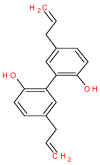Magnolol: A Neolignan from the Magnolia Family for the Prevention and Treatment of Cancer
- PMID: 30103472
- PMCID: PMC6121321
- DOI: 10.3390/ijms19082362
Magnolol: A Neolignan from the Magnolia Family for the Prevention and Treatment of Cancer
Abstract
The past few decades have witnessed widespread research to challenge carcinogenesis; however, it remains one of the most important health concerns with the worst prognosis and diagnosis. Increasing lines of evidence clearly show that the rate of cancer incidence will increase in future and will create global havoc, designating it as an epidemic. Conventional chemotherapeutics and treatment with synthetic disciplines are often associated with adverse side effects and development of chemoresistance. Thus, discovering novel economic and patient friendly drugs that are safe and efficacious is warranted. Several natural compounds have proved their potential against this dreadful disease so far. Magnolol is a hydroxylated biphenyl isolated from the root and stem bark of Magnolia tree. Magnolol can efficiently prevent or inhibit the growth of various cancers originating from different organs such as brain, breast, cervical, colon, liver, lung, prostate, skin, etc. Considering these perspectives, the current review primarily focuses on the fascinating role of magnolol against various types of cancers, and the source and chemistry of magnolol and the molecular mechanism underlying the targets of magnolol are discussed. This review proposes magnolol as a suitable candidate that can be appropriately designed and established into a potent anti-cancer drug.
Keywords: cancer; chemoresistance; magnolol; molecular targets; phytochemicals.
Conflict of interest statement
The authors declare no conflict of interest.
Figures



Similar articles
-
Discovery and synthesis of novel magnolol derivatives with potent anticancer activity in non-small cell lung cancer.Eur J Med Chem. 2018 Aug 5;156:190-205. doi: 10.1016/j.ejmech.2018.06.048. Epub 2018 Jun 27. Eur J Med Chem. 2018. PMID: 30006164
-
Honokiol for cancer therapeutics: A traditional medicine that can modulate multiple oncogenic targets.Pharmacol Res. 2019 Jun;144:192-209. doi: 10.1016/j.phrs.2019.04.004. Epub 2019 Apr 17. Pharmacol Res. 2019. PMID: 31002949 Review.
-
Magnolol Inhibits the Growth of Non-Small Cell Lung Cancer via Inhibiting Microtubule Polymerization.Cell Physiol Biochem. 2017;42(5):1789-1801. doi: 10.1159/000479458. Epub 2017 Jul 26. Cell Physiol Biochem. 2017. PMID: 28746938
-
Synthesis and evaluation of new compounds bearing 3-(4-aminopiperidin-1-yl)methyl magnolol scaffold as anticancer agents for the treatment of non-small cell lung cancer via targeting autophagy.Eur J Med Chem. 2021 Jan 1;209:112922. doi: 10.1016/j.ejmech.2020.112922. Epub 2020 Oct 10. Eur J Med Chem. 2021. PMID: 33069436
-
Advances on Semisynthesis, Total Synthesis, and Structure-Activity Relationships of Honokiol and Magnolol Derivatives.Mini Rev Med Chem. 2016;16(5):404-26. doi: 10.2174/1389557516666151120115558. Mini Rev Med Chem. 2016. PMID: 26586125 Review.
Cited by
-
Effects of magnolol on egg production, egg quality, antioxidant capacity, and intestinal health of laying hens in the late phase of the laying cycle.Poult Sci. 2021 Feb;100(2):835-843. doi: 10.1016/j.psj.2020.10.047. Epub 2020 Nov 2. Poult Sci. 2021. PMID: 33518137 Free PMC article.
-
Methods for Overcoming Chemoresistance in Head and Neck Squamous Cell Carcinoma: Keeping the Focus on Cancer Stem Cells, a Systematic Review.Cancers (Basel). 2024 Aug 29;16(17):3004. doi: 10.3390/cancers16173004. Cancers (Basel). 2024. PMID: 39272862 Free PMC article. Review.
-
Reiterating the Emergence of Noncoding RNAs as Regulators of the Critical Hallmarks of Gall Bladder Cancer.Biomolecules. 2021 Dec 8;11(12):1847. doi: 10.3390/biom11121847. Biomolecules. 2021. PMID: 34944491 Free PMC article. Review.
-
The LXR-623-induced long non-coding RNA LINC01125 suppresses the proliferation of breast cancer cells via PTEN/AKT/p53 signaling pathway.Cell Death Dis. 2019 Mar 13;10(3):248. doi: 10.1038/s41419-019-1440-5. Cell Death Dis. 2019. PMID: 30867411 Free PMC article.
-
Focus on Formononetin: Anticancer Potential and Molecular Targets.Cancers (Basel). 2019 May 1;11(5):611. doi: 10.3390/cancers11050611. Cancers (Basel). 2019. PMID: 31052435 Free PMC article. Review.
References
Publication types
MeSH terms
Substances
LinkOut - more resources
Full Text Sources
Other Literature Sources
Miscellaneous

